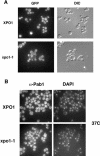Yeast poly(A)-binding protein Pab1 shuttles between the nucleus and the cytoplasm and functions in mRNA export
- PMID: 15769879
- PMCID: PMC1370741
- DOI: 10.1261/rna.7291205
Yeast poly(A)-binding protein Pab1 shuttles between the nucleus and the cytoplasm and functions in mRNA export
Abstract
Pab1 is the major poly(A)-binding protein in yeast. It is a multifunctional protein that mediates many cellular functions associated with the 3'-poly(A)-tail of messenger RNAs. Here, we characterize Pab1 as an export cargo of the protein export factor Xpo1/Crm1. Pab1 is a major Xpo1/Crm1-interacting protein in yeast extracts and binds directly to Xpo1/Crm1 in a RanGTP-dependent manner. Pab1 shuttles rapidly between the nucleus and the cytoplasm and partially accumulates in the nucleus when the function of Xpo1/Crm1 is inhibited. However, Pab1 can also be exported by an alternative pathway, which is dependent on the MEX67-mRNA export pathway. Import of Pab1 is mediated by the import receptor Kap108/Sxm1 through a nuclear localization signal in its fourth RNA-binding domain. Interestingly, inhibition of Pab1's nuclear import causes a kinetic delay in the export of mRNA. Furthermore, the inviability of a pab1 deletion strain is suppressed by a mutation in the 5'-3' exoribonuclease RRP6, a component of the nuclear exosome. Therefore, nuclear Pab1 may be required for efficient mRNA export and may function in the quality control of mRNA in the nucleus.
Figures







Similar articles
-
Uncoupling of the hnRNP Npl3p from mRNAs during the stress-induced block in mRNA export.Genes Dev. 1999 Aug 1;13(15):1994-2004. doi: 10.1101/gad.13.15.1994. Genes Dev. 1999. PMID: 10444597 Free PMC article.
-
Rat8p/Dbp5p is a shuttling transport factor that interacts with Rat7p/Nup159p and Gle1p and suppresses the mRNA export defect of xpo1-1 cells.EMBO J. 1999 Oct 15;18(20):5778-88. doi: 10.1093/emboj/18.20.5778. EMBO J. 1999. PMID: 10523319 Free PMC article.
-
Spatial regulation of the KH domain RNA-binding protein Rnc1 mediated by a Crm1-independent nuclear export system in Schizosaccharomyces pombe.Mol Microbiol. 2017 May;104(3):428-448. doi: 10.1111/mmi.13636. Epub 2017 Feb 24. Mol Microbiol. 2017. PMID: 28142187
-
A novel family of nuclear transport receptors mediates the export of messenger RNA to the cytoplasm.Eur J Cell Biol. 2002 Nov;81(11):577-84. doi: 10.1078/0171-9335-00273. Eur J Cell Biol. 2002. PMID: 12498157 Review.
-
Inhibition of CRM1-dependent nuclear export sensitizes malignant cells to cytotoxic and targeted agents.Semin Cancer Biol. 2014 Aug;27:62-73. doi: 10.1016/j.semcancer.2014.03.001. Epub 2014 Mar 12. Semin Cancer Biol. 2014. PMID: 24631834 Free PMC article. Review.
Cited by
-
Importin alpha-mediated nuclear import of cytoplasmic poly(A) binding protein occurs as a direct consequence of cytoplasmic mRNA depletion.Mol Cell Biol. 2011 Aug;31(15):3113-25. doi: 10.1128/MCB.05402-11. Epub 2011 Jun 6. Mol Cell Biol. 2011. PMID: 21646427 Free PMC article.
-
Early recruitment of AU-rich element-containing mRNAs determines their cytosolic fate during iron deficiency.Mol Cell Biol. 2011 Feb;31(3):417-29. doi: 10.1128/MCB.00754-10. Epub 2010 Dec 6. Mol Cell Biol. 2011. PMID: 21135132 Free PMC article.
-
Dosage suppressors of gpn2ts mutants and functional insights into the role of Gpn2 in budding yeast.PLoS One. 2024 Dec 6;19(12):e0313597. doi: 10.1371/journal.pone.0313597. eCollection 2024. PLoS One. 2024. PMID: 39642114 Free PMC article.
-
The functionality of telomerase depends on CPF-CF induced 3'end processing of its RNA component TLC1 and a novel Nrd1-Nab3 surveillance mechanism.Nucleic Acids Res. 2025 Jun 6;53(11):gkaf480. doi: 10.1093/nar/gkaf480. Nucleic Acids Res. 2025. PMID: 40488281 Free PMC article.
-
Bunyaviral N Proteins Localize at RNA Processing Bodies and Stress Granules: The Enigma of Cytoplasmic Sources of Capped RNA for Cap Snatching.Viruses. 2022 Jul 29;14(8):1679. doi: 10.3390/v14081679. Viruses. 2022. PMID: 36016301 Free PMC article.
References
-
- Afonina, E., Stauber, R., and Pavlakis, G.N. 1998. The human poly(A)-binding protein 1 shuttles between the nucleus and the cytoplasm. J. Biol. Chem. 273: 13015–13021. - PubMed
Publication types
MeSH terms
Substances
Grants and funding
LinkOut - more resources
Full Text Sources
Other Literature Sources
Molecular Biology Databases
